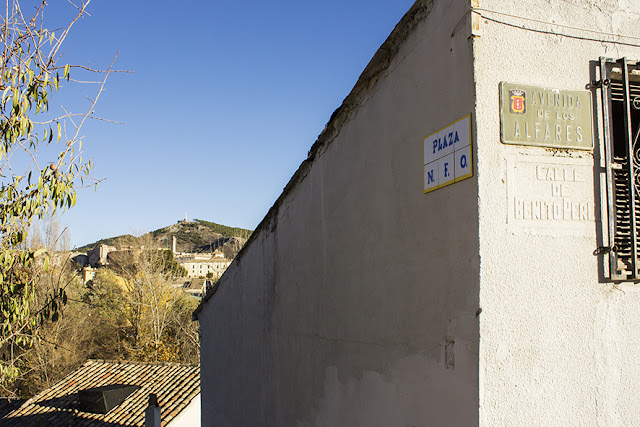Los nombres de las calles, cuentan mucho de una ciudad o un
país, tanto en su estética como en su contenido. Normalmente homenajes a
escritores, artistas, políticos o incluso equipos de fútbol, como es el caso de
unas cuantas calles situadas en el barrio de Pan Bendito en Madrid.
Todos estos nombres son impuestos por el poder institucional
de cada ciudad, sin contar con la memoria o historia de cada barrio, algo muy
común en España, donde aun quedan un gran número de calles que hacen referencia
al franquismo.
También se las ha llegado a ver como un recurso
"turístico", utilizando nombres peculiares, como es el caso de Leganés
con sus calles "AC/DC" o "Rosendo".
Una de las mayores peculiaridades que tienen estas señales
suele ser su diseño, bien diferenciado dependiendo del lugar que ocupen en la
ciudad. Comúnmente las situadas en el casco histórico o en la parte más
turística de cada ciudad tienen un halo de ennoblecimiento que dista del resto,
normalmente hechas en chapa.
Esta señalización situada en las zonas nobles de la ciudad,
normalmente hechas de azulejo decorado a mano, crean una evidente
diferenciación de clase entre el barrio y el centro histórico.
El proyecto pretende dar más identidad si cabe al barrio de
San Antón, dando el poder al ciudadano, contraponiendo el centro y lo turístico
frente al barrio y lo habitual.
Para ello se realizó un taller de pintura cerámica, que
consistió en realizar una serie de nuevas calles para el barrio de San Antón,
no calles a poetas o pintores ya muertos, sino con el nombre que cada vecino
eligió con total libertad.
Partiendo estéticamente de las placas de azulejo que dan
nombre a las calles del casco histórico de Cuenca, se realizaron unas
semejantes para el barrio de San Antón.
Después del taller los azulejos con los nuevos nombres
fueron cocidos, para posteriormente ser colocadas de forma autónoma y sin
permisos institucionales en el lugar que cada vecino eligió.
The names of the streets, have much of a city or a country, in its aesthetics and content. Normally tributes to writers, artists, politicians or even football teams, as in the case of a few streets in the district of Pan Bendito in Madrid.
All of these names are set by the institutional power of each city, without memory or history of each neighborhood, which is very common in Spain, where there are still a large number of streets that refer to Franco.
The also they have come to see as a "tourist" resort, using unique names, such as streets Leganes with "AC / DC" or "Rosendo".
One of the major features that have these signals is usually its design, well-differentiated depending on where they are in town. Commonly located in the historic center or in the tourist part of every city with an aura of ennoblement that is far from the rest, usually made of sheet.
This signal is located in the public areas of the city, usually made of hand decorated tiles, creating a clear class differentiation between the district and the historic center.
The project aims to give more identity if it fits the neighborhood of San Anton and empowers citizens, opposing the center and in front of the tourist district and the usual.
To do a pottery painting, which consisted of a series of new streets to the San Anton, no streets to painters and poets or dead, but the name you chose each neighbor freely performed.
Starting aesthetically tile plates that give name to the streets of the historic center of Cuenca, a fellow were made to the San Anton.
After the workshop tiles with new names were cooked to later be placed independently and without institutional permits in place that each neighbor chose.
All of these names are set by the institutional power of each city, without memory or history of each neighborhood, which is very common in Spain, where there are still a large number of streets that refer to Franco.
The also they have come to see as a "tourist" resort, using unique names, such as streets Leganes with "AC / DC" or "Rosendo".
One of the major features that have these signals is usually its design, well-differentiated depending on where they are in town. Commonly located in the historic center or in the tourist part of every city with an aura of ennoblement that is far from the rest, usually made of sheet.
This signal is located in the public areas of the city, usually made of hand decorated tiles, creating a clear class differentiation between the district and the historic center.
The project aims to give more identity if it fits the neighborhood of San Anton and empowers citizens, opposing the center and in front of the tourist district and the usual.
To do a pottery painting, which consisted of a series of new streets to the San Anton, no streets to painters and poets or dead, but the name you chose each neighbor freely performed.
Starting aesthetically tile plates that give name to the streets of the historic center of Cuenca, a fellow were made to the San Anton.
After the workshop tiles with new names were cooked to later be placed independently and without institutional permits in place that each neighbor chose.
Diferentes estilos de placas de la ciudad de Cuenca.
Different styles of plates Cuenca.
Different styles of plates Cuenca.




























